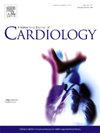STEMI患者急诊医疗服务呼叫延迟的因素及其对预后的影响:来自CCA数据库-胸痛中心登记的结果
IF 3.2
2区 医学
Q2 CARDIAC & CARDIOVASCULAR SYSTEMS
引用次数: 0
摘要
背景:紧急医疗服务(EMS)呼叫延迟占院前延迟的很大一部分,这可能影响st段抬高型心肌梗死(STEMI)患者的预后。本研究的目的是确定导致STEMI患者EMS呼叫延迟的因素,并评估EMS呼叫延迟与院内死亡率之间的关系。方法:对中国胸痛中心数据库中2020年1月至2023年12月的数据进行回顾性分析。根据STEMI患者特征对EMS呼叫延迟进行描述,并进行多变量线性回归分析,探索与EMS呼叫延迟相关的独立因素。采用局部加权回归(黄土)拟合死亡率随急救呼叫延迟的变化趋势。采用Logistic回归分析急诊呼叫延迟与住院死亡率的关系。结果:本研究共纳入115,113例STEMI患者。EMS呼叫延迟时间中位数为46 min。亚组分析显示,与EMS呼叫时间超过60 min相关的特征包括年龄 ≥ 65 岁、女性、非持续性胸痛/胸闷和夜间症状发作。心血管死亡率、院内死亡率和院内并发症发生率均与EMS呼叫延迟时间呈线性正相关。EMS呼叫延迟的独立危险因素为年龄、女性、非持续性胸痛/胸闷、夜间症状发作。结论:公共卫生倡议应关注老年人、女性和夜间症状发作或非持续性胸痛的个体,以促进及时激活EMS并降低死亡率。本文章由计算机程序翻译,如有差异,请以英文原文为准。
Factors of emergency medical services call delay and its impact on prognosis in STEMI patients: Findings from the CCA database-chest pain center registry
Background
A delay in calls to emergency medical services (EMS) accounts for a substantial portion of prehospital delay, which may affect the prognosis of patients with ST-elevation myocardial infarction (STEMI).The objective of this study was to identify factors contributing to EMS call delay in patients with STEMI and evaluate the association between EMS call delay and in-hospital mortality.
Methods
A retrospective analysis was conducted between January 2020 and December 2023 from the China Chest Pain Center database. EMS call delays were described according to STEMI patients characteristics, and multivariable linear regression analysis was performed to explore independent factors related to EMS call delays. Locally weighted regression (LOESS) was used to fit the trend of mortality with EMS call delays. Logistic regression was used to analyze the relationship between EMS call delay and in-hospital mortality.
Results
This study included a total of 115,113 STEMI patients. The median EMS call delay time was 46 min. Subgroup analysis revealed that characteristics associated with an EMS call time exceedi ng 60 min included age ≥ 65 years, female sex, non-persistent chest pain/tightness, and nighttime symptom onset. Cardiovascular mortality, in-hospital mortality, and the incidence of in-hospital complications all exhibited a linear positive correlation with EMS call delay time. The independent risk factors for EMS call delay were age, female sex, non-persistent chest pain/tightness, and nighttime symptom onset.
Conclusions
Public health initiatives should focus on older adults, females, and individuals with nighttime symptom onset or nonpersistent chest pain to promote timely EMS activation and reduce mortality.
求助全文
通过发布文献求助,成功后即可免费获取论文全文。
去求助
来源期刊

International journal of cardiology
医学-心血管系统
CiteScore
6.80
自引率
5.70%
发文量
758
审稿时长
44 days
期刊介绍:
The International Journal of Cardiology is devoted to cardiology in the broadest sense. Both basic research and clinical papers can be submitted. The journal serves the interest of both practicing clinicians and researchers.
In addition to original papers, we are launching a range of new manuscript types, including Consensus and Position Papers, Systematic Reviews, Meta-analyses, and Short communications. Case reports are no longer acceptable. Controversial techniques, issues on health policy and social medicine are discussed and serve as useful tools for encouraging debate.
 求助内容:
求助内容: 应助结果提醒方式:
应助结果提醒方式:


